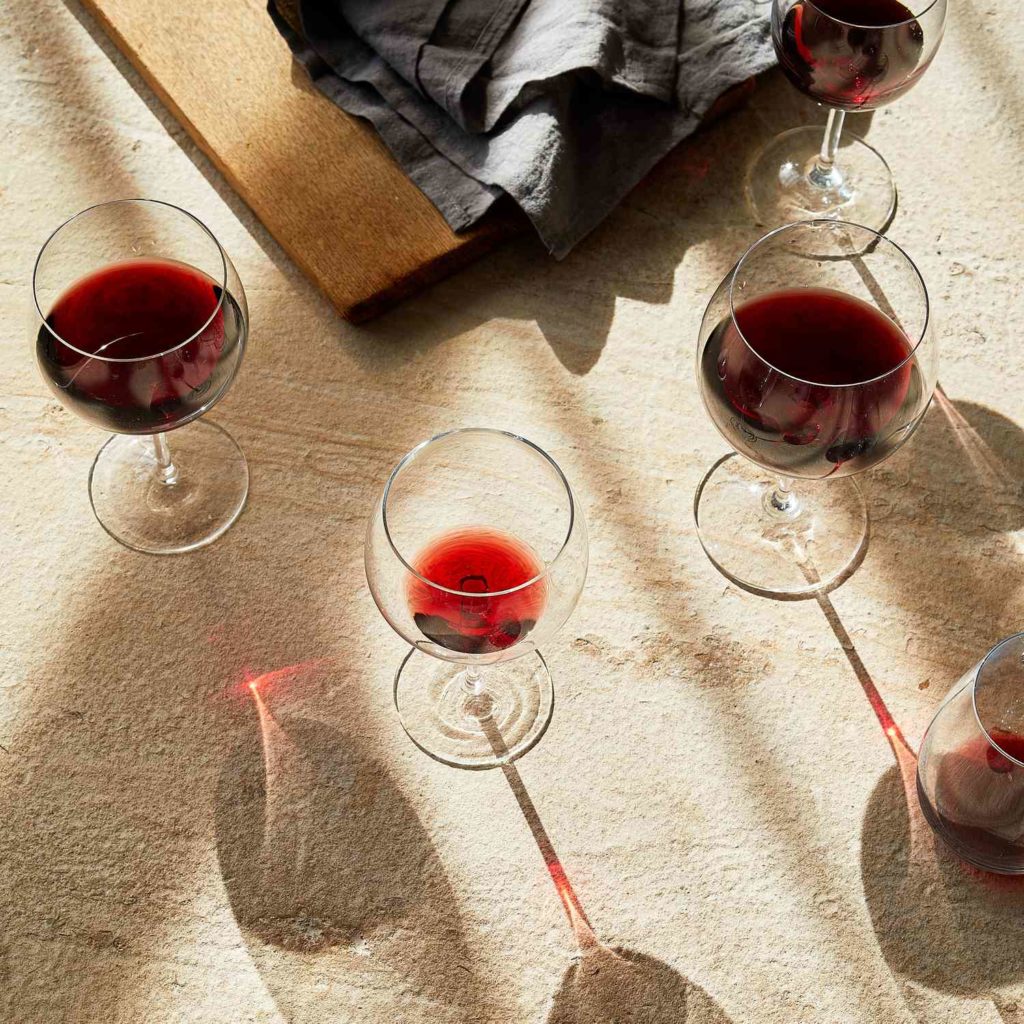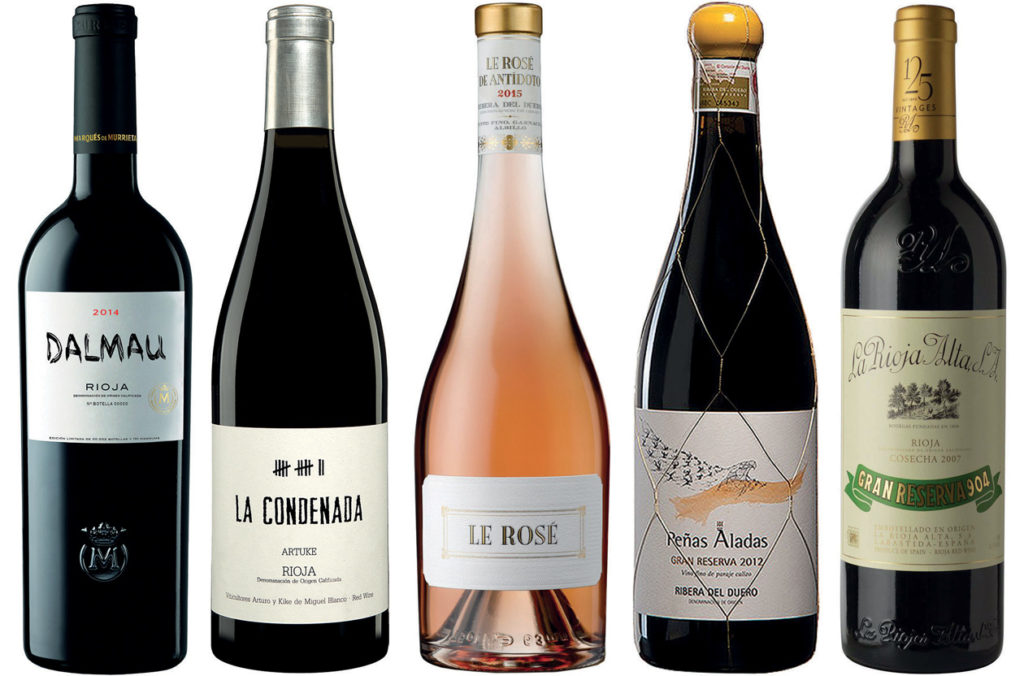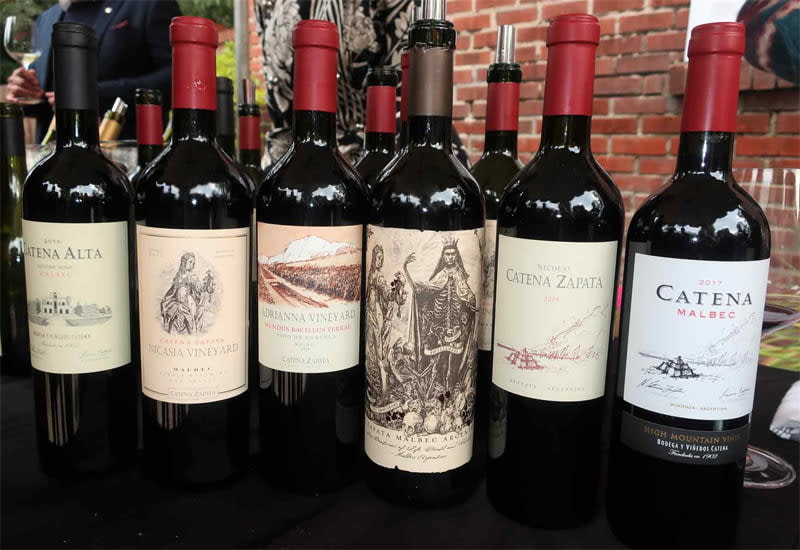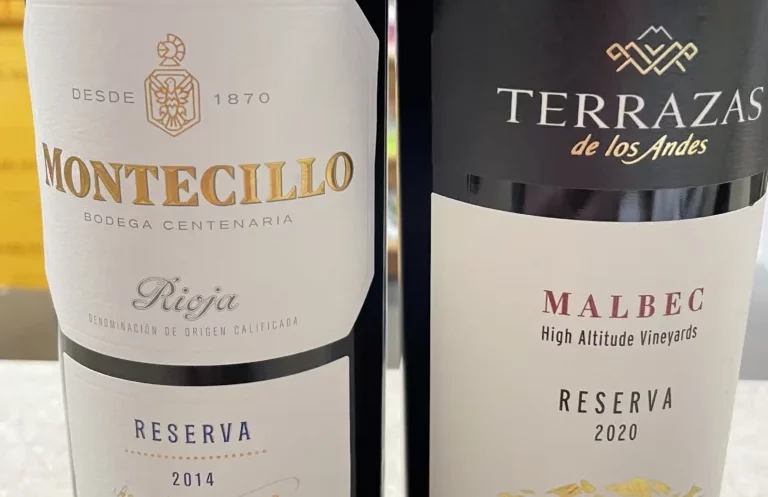There are countless options when we mention red wine. Malbec and Tempranillo have distinguished themselves from the variety of possibilities due to their remarkable quality and unique traits. We will compare Malbec and Tempranillo in the post Tempranillo vs Malbec by looking at their histories, flavor characteristics, and recommendations for the best ways to drink both.
1. Similarities of Tempranillo vs Malbec
First of all, we will give you a comparison table to summarize the similarities and differences between Malbec and Tempranillo:
|
Malbec |
Tempranillo |
|
| Origin | France, Argentina | Spain |
| Tasting notes | Blackberries, plums, and black cherries or sour currant, leather… | Cherries, dried figs, cedar, and tobacco. |
| ABV | 13 – 14% | 13.5 – 15% |
| Shelf life | 2 – 3 years | 2 – 3 years |
| Grape varieties | Purple grapes from France | Black grapes from Spain |
| Food pairings | Meaty dishes | Spanish dishes |
| Description | Full-bodied red wine with dark fruit flavors and smoky finish. | Medium-bodied red wine with low-to-medium acidity as well as smooth tannins. |
Editor’s note: Please be aware that these are only basic characteristics and that locations and winemaking techniques might affect particular wines differently.
Despite their differences, some slight similarities between Tempranillo and Malbec go beyond only their shared tobacco aroma. Style, cuisine combinations, and alcohol content are a few of these.
The dry-style wines that are most frequently produced from Tempranillo and Malbec go well with lamb and beef dishes. They both have the following amounts of alcohol, which are extremely comparable.
2. Exploring The Differences: Tempranillo vs Malbec
Malbec and Tempranillo are both red wines, both of which match well with meats and both of which have tobacco flavors, but they are not the same wine.
They are distinct from one another since they each come from two distinct places, and have different parent grapes as well as other different points.

Grape varieties:
Malbec is a red wine created from purple grapes that comes from France, whereas Tempranillo is a red wine produced from merely black grapes that come from Spain.
Tasting notes:
- Malbec:
Malbec’s flavor characteristics vary depending on the location since Malbec cultivated in Argentina may taste different than Malbec produced in France.
The main fruits used in Argentina are blackberries, plums, and black cherries. In France, it features flavors of sour currant, leather, and a hint of savory bitterness.
- Tempranillo:
The flavors of Tempranillo wine include cherries, dried figs, cedar, and tobacco. Tempranillo’s tastes are influenced by age, which adds heat and aromas of luscious fruit.
Shelf life:
Malbec, in contrast to Tempranillo, can age for quite a while while maintaining its flavor; yet, when Tempranillo ages, it begins to take on an oaky flavor that indicates aging.
Tempranillo and Malbec have a shelf life of up to two to three years beyond their expiration dates, but once opened and drunk, they should be consumed within three to five days
You can also like:
- Chenin Blanc vs Sauvignon Blanc: Which ONE is Better?
- Why Does Red Wine Make Your Poop Dark? The Ultimate Answer
- Difference Between Moscato And Prosecco – A Complete Guide
3. Which to choose: Tempranillo or Malbec
Your particular preferences will determine whether you choose Tempranillo or Malbec.
Tempranillo is a fantastic option if you like lighter wines with delicate notes. Tempranillo may be the apple of your eye if you’re seeking for a light-bodied red wine with mild tannins and acidity.
Malbec could be more your style if you’re seeking for a full-bodied red wine with high tannins and acidity. Malbec may also be a better option if you want a wine that is stronger and has more powerful characteristics. For spiciness, smokey taste, and other powerful food flavors, Malbec is a traditional option.
4. What is Tempranillo?

Origin:
Tempranillo is the principal vine of Rioja, Spain’s famed, rich, American-oak-aged reds.
Tempranillo-based wines with years of age may be purchased for just a tiny percentage of the cost of comparably renowned wines coming from Bordeaux or Napa, making Spanish wines among the most incredible bargains in the world.
Style
In Spain, the more pricey wines usually spend time in oak; in fact, their grade system (which is, in our opinion, a little out of date) is based on time matured in oak.
Tempranillo can be Joven, Crianza, Reserva or Gran Reserva. Joven refers to young or unoaked wines, Crianza to wines that have been in oak for a short time, Reserva to wines that have been in wood for at least a year, and Gran Reserva to wines that have been in oak for at least two years. The more pricey the more time you spend in oak.
Tasting notes:
Spanish Tempranillo features loads of dried red plum, leather, and cherries, all of which have opposing characteristics. Along with leather, clay, and a variety of spices, it will probably also have a hint of red flowers. The harmony between fruit and earth is more apparent in more expensive wines.
Usually, the aftertaste is silky, and you can still taste its tannin on each side of your tongue. Expect more leather, nuttiness, chocolate, and coffee as the wine ages. Tempranillo is classified as medium- to full-bodied with red fruit flavors.
ABV:
Due to its high alcohol content (in the range of 13.5% and 15% ABV), Tempranillo is generally utilized as an underlying wine for the famed Rioja mixtures.
Food pairings:
A wide range of meals go well with Tempranillo because of its delicious characteristics. Regional Spanish food, which features roasted veggies and cured meats like the luscious Jamón Iberico de Bellota, makes an excellent complement.
The wine, however, has diversity and goes well with both international cuisine and regional Spanish cuisine.
5. What is Malbec?

Origin
If you’re unfamiliar with Malbec, you could be forgiven for assuming that Argentina is where it originated.
Although Argentina produces almost entirely of the world’s Malbec, the wine originated in France and is now grown in several other nations. This does not imply that this is a grape that is simple to get used to.
Style
Malbec is a full-bodied red wine grown mostly in Argentina. Malbec wine, which is known for its ripe, blackberry notes and smokey finish, is a suitable substitute for more expensive wines such as Cabernet Sauvignon or Syrah.
Malbec is a dry red wine that tastes strongly of black fruits. Given its substantial body and plenty of ripe fruit, Malbec is unquestionably thought of as a heavier red.
Tasting notes
The primary fruit tastes in an Argentine Malbec glass are blackberries, plums, and black cherries. The complex tastes include chocolate with milk, powdered cocoa, violet flowers, leather, and, based on the degree of oak age, a sweet tobacco aftertaste.
Malbec from Argentina is fruit-forward, but Malbec in France is the complete opposite. It is leathery, with tastes of sour currant, black plums, and savory bitterness that is sometimes characterized as starting green and comes from the Cahors area.
ABV
Malbec wines typically have an alcohol content of 13–14%. This is equivalent to Chardonnay, Merlot, and Cabernet Sauvignon.
For comparison’s sake, an ABV of 14.5% or more is regarded as being excessively alcoholic, although certain mixes of Merlot, Cabernet Sauvignon, Shiraz, Syrah, as well as Zinfandel do include ABVs that are greater than that.
Food pairings
With meatier dishes like salmon and fowl with dark meat, as well as with steak, hog, and lamb, malbec pairs exceptionally well. It’s also a good idea to consume game meat like bison, ostrich, or venison. Consider meals with thicker sauces or more robust tastes along with meat pairings.
7. Tips to get the most out of a glass of Tempranillo and Malbec

For enhancing the flavor and aroma of wines, there are several options available. Everybody is aware that the meal with which a wine is served has a big impact on its flavor, but other aspects like as temperatures and glassware may additionally enhance the wine. Here are some suggestions for making the most of a sip of Malbec and Tempranillo:
Tempranillo:
- Temperature:
Tempranillo wine should be served at room temperature. Around 18°C (65°F) is the perfect temperature. As the temperature drops, the wine’s scent is kept from leaking. So, avoid putting the wine bottle in the refrigerator. Do not store the bottle of wine in a bucket of ice either.
Red Tempranillo wine should be chilled for a half-hour before serving. The wine is then decanted or the first glass is poured, and it is left to sit on the table for 10 minutes to warm and breathe before being consumed.
- Glassware:
The “Standard” Red Wine Glass is ideal for medium- to full-bodied red wine with spicy characteristics and/or high alcohol content. Due to the more gradual taste delivery from the narrower aperture, the spice will be softened. Because of this, it pairs perfectly with Tempranillo.
Malbec:
- Temperature:
Serve Malbec wine at room temperature. Around 18°C (65°F) is the perfect temperature. Cooler temperatures run the danger of stopping the aromas in Malbec wines from being released.
So, avoid putting the wine bottle in the refrigerator. Do not store the bottle in a bucket of ice either.
Malbec wines don’t need to be chilled before serving. Do not chill glasses in the refrigerator. The wine loses flavor and is diluted by the condensation.
Pour the entire bottle into a decanter before serving. Malbec should generally be kept in a decanter for about thirty to sixty minutes.
- Glass:
Red Bordeaux blends, Barolo, and yes, Malbec, all benefit from a wide bowl since the surface area is larger and allows for more air contact. Pick a big and wide glass. The wine becomes softer and more enjoyable to drink as the tannins are broken down by the air.
8. Tips for pairing Tempranillo and Malbec with different foods

Tempranillo:
- Tempranillo with Lamb:
Lamb is a traditional meal combination with Tempranillo. Lamb burgers, lamb chops, lamb on the grill, etc. Tempranillo pairs well with everything that contains lamb! Herbs like rosemary, thyme, and oregano are frequently used in lamb meals. These herbs will go fantastically with the wine’s savory notes.
- Tempranillo with Manchego cheese:
The traditional cheese pairing with Tempranillo is Manchego. It is also made in Spain using Manchega sheep milk. Spanish grapes’ aridity and vivid red fruit tastes provide the perfect counterpoint to Manchego’s somewhat oily, slightly acidic taste and strong smells.
The majority of sheep’s milk cheeses are sufficiently salty and grainy to counteract the Tempranillo’s smooth and fruit-forward flavor.
Malbec:
- Malbec with Dark roasted turkey:
Pour a Cahors Malbec beside your turkey to liven up the Thanksgiving meal. The wine’s inherent sharpness and fruitiness will counteract the richness of the mushroom gravy, the buttery potatoes, and the sausage cornbread stuffing. It has the lushness and fruit to match the luscious dark turkey meat.
- Malbec with Cheese:
Malbec is one of the few strong red wines that dependably matches nicely with blue cheese as well as other soft cheeses. Moreover, melted Swiss cheese, provolone, and Monterey Jack cheese will also make you happy.
The key to mixing Malbec with cheese is to be aware that the finish isn’t particularly lengthy; hence, a cheese that doesn’t have a particularly long, lingering flavor is usually a suitable fit. Cashew creams with stronger herb tastes would satisfy vegan cheese makers.
9. FAQs
Q: Is Tempranillo similar to Malbec?
The wines are fairly similar in flavor and place of origin, yet they are distinct from one another. Don’t miss the opportunity to compare them side by side if you have the chance. First off, Malbec is a French grape, whereas tempranillo is a Spanish grape. Second, malbec wines tend to have a fuller body than tempranillo wines.
Q: Is the wine Tempranillo sweet?
The red wine Tempranillo is thought to be quite dry. This full-bodied red wine from Spain has strong tannins, high acidity, and delectable flavors of dried figs, cherries, and tobacco.
Q: Is Malbec light or heavy?
Malbec is frequently used in blends, such as the red French Bordeaux claret mix, which combines Malbec with Merlot and Cabernet Sauvignon to produce a somewhat strong, inky crimson (or violet) wine. In places like the Loire Valley, the grape is combined with Cabernet Franc and Gamay.
Q: Tempranillo or Malbec, which is drier?
Compared to Malbec, Tempranillo is said to be drier because of its spicier dill and cedar flavors. However, because of the presence of aromas of vanilla and chocolate, Malbec is said to be sweeter.
Q: Is Tempranillo a heavy wine?
Tempranillo wine has a medium body and strong tannin and alcohol levels. If you enjoy medium-bodied red wines like Merlot, Tempranillo is a wine variety to hunt for.
Q: How acidic is Malbec?
Malbec is a rich red wine with a moderately low acidity that occasionally exhibits flavor characteristics of blackberries, dark cherries, plum, and olive. Wine enthusiasts from all over the world are drawn to it by its velvety, silky texture.
Q: Why is just Argentina used to produce Malbec?
Malbec grapes love the sun, but they can’t handle really hot temperatures. Malbec thrives best in the dry, colder temperature of Argentina’s high-altitude vineyards, which are ideal for growth conditions.
Q: Do you prefer your Malbec hot or cold?
Malbec tastes best when served at a temperature of 15–18°C (60–65°F), or slightly below room temperature.
Q: What dishes go well with Malbec?
With meatier dishes like salmon and fowl with dark meat, as well as with steak, hog, and lamb, malbec pairs exceptionally well. It’s also a good idea to consume game meat like bison, ostrich, and venison. Think of items with thicker sauces or more brilliant colors in addition to meat combinations.
Q: What dishes go well with Malbec?
With meatier dishes like salmon and fowl with dark meat, as well as with steak, hog, and lamb, malbec pairs exceptionally well. It’s also a good idea to consume game meat like bison, ostrich, and venison. Think of items with thicker sauces or more brilliant colors in addition to meat combinations.
Q: Is Malbec full-bodied or light-bodied?
A fantastic illustration of a well-known, full-bodied red wine is Malbec. Although Chile and France also produce it, Argentina is the country that produces the most grapes. It is a medium-tannic wine with mild tannins that features fruits like black cherries, pomegranates, plums, and raisins.
10. Conclusion
In conclusion, the article compares the two red wine varietals Malbec vs Tempranillo, and emphasizes their unique characteristics and excellent qualities. Both wines are well-known internationally and are loved by wine lovers everywhere. We hope that our post-Malbec vs. Tempranillo was helpful to you in making a wise decision.

In 2014, Leo Colon began working with Big Cottonwood Winery. Over the years he has remained part of this prestigious winery’s team and is also a contributor to other notable wine publications. As an ardent advocate for knowledge, Leo continues his vinous education to this day.

